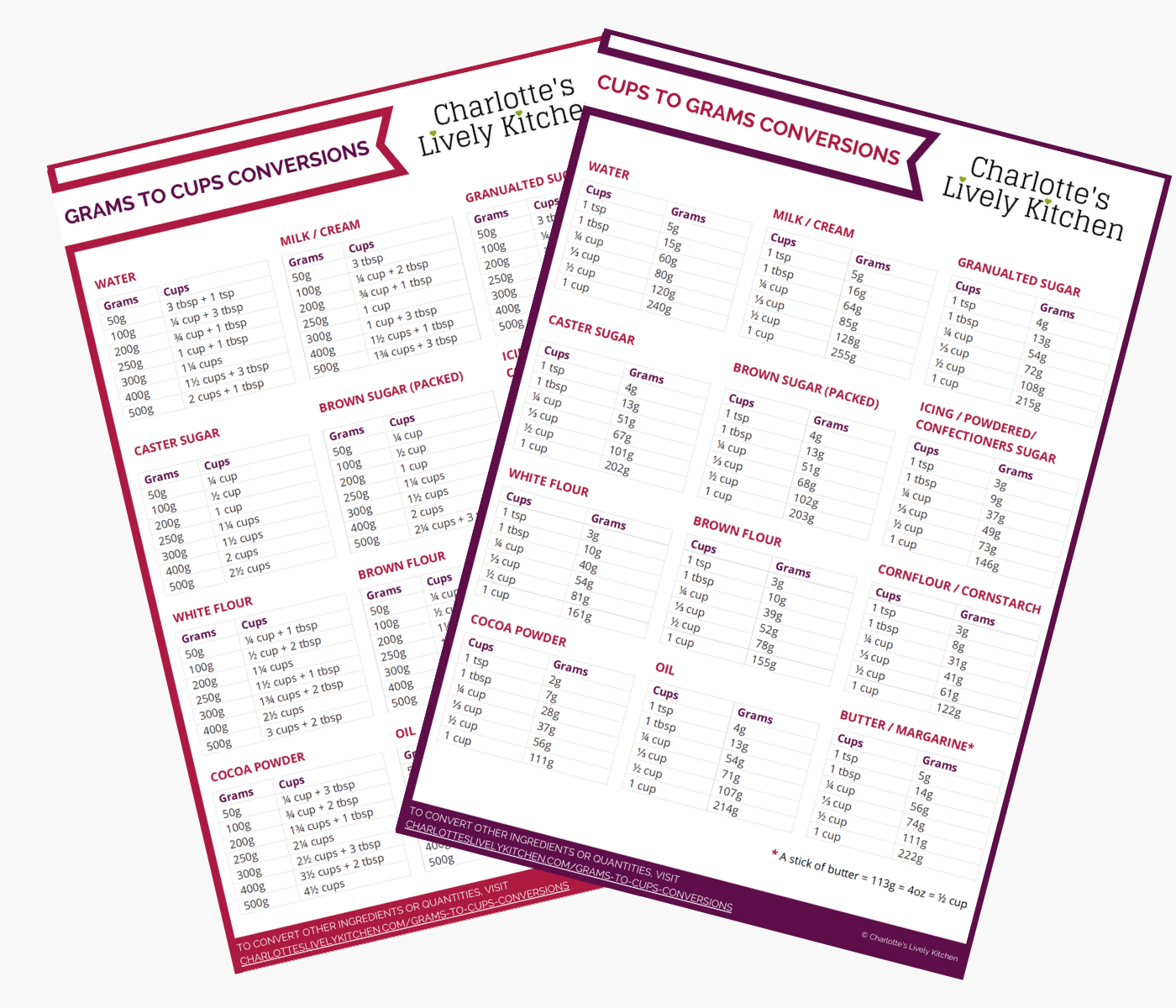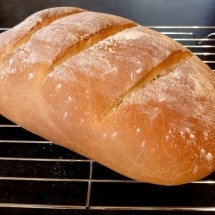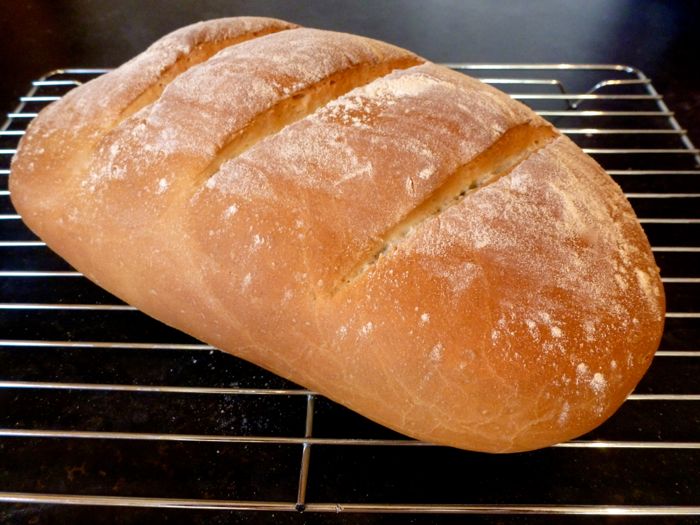Bread is one of my favourite things to make and with this basic white bread recipe it’s really simple to make and tastes delicious.
Bread is one of my favourite foods to make. It’s quick to make (proving aside), I find kneading the dough great for relaxing and de-stressing, it fills your house with a lovely fresh bread aroma, and I don’t know if it’s just me but I always feel quite pleased with myself when I return to the dough after an hour or so to find it’s risen.
This recipe is for a small white loaf which is what I prefer to make, but you can easily double the recipe to make a larger loaf, or make two at a time and pop one in the freezer.
If you prefer to make your bread in a tin, for this recipe I would recommend using a 1lb loaf tin.
FREE GRAMS TO CUPS CONVERSION CHARTS

Subscribe to the Charlotte's Lively Kitchen mailing list to get your FREE printable grams to cups and cups to grams conversion charts for twelve popular baking ingredients

Basic white bread
INGREDIENTS
- 300 g strong white bread flour
- 150 ml tepid water - approx.
- 1 tsp fast action dried yeast
- 1 tsp salt
- 1 tbsp olive oil
INSTRUCTIONS
- Put the flour (300g), yeast (1 tsp) and salt (1 tsp) into a large bowl - Put the salt and yeast on opposite sides of the bowl to prevent the salt killing the yeast before it's had a chance to work.
- Make a well in the centre and add half the water (75ml), mix well with your hands.
- Keep adding water a little bit at a time until all of the flour has been incorporated into the dough. The dough should be slightly sticky but not sloppy - You may not need to full 150ml listed, keep adding a little water at a time until all the flour is incorporated into the dough. If you accidentally add too much water add a sprinkle of flour and combine until you have the right consistency.
- Spread a little of the olive oil onto a clear work surface and knead the dough in the oil, keep adding a little oil until the full 1 tbsp has been incorporated - The olive oil helps to prevent the dough from sticking to the surface and adds flavour to the loaf. The dough can sometimes get sticky while kneading, keep persevering, it will improve, and don't be tempted to add more flour or you'll end up with a dry, heavy loaf.
- Keep kneading the dough until it is smooth, springy and if you stretch it in front of a light source you'll be able to see the light coming through without the dough breaking.
- Put the dough into a lightly oiled bowl and cover with cling film. Leave to prove for 1-1½ hours (or overnight in the fridge) until the dough has doubled in size - The important thing here is the dough doubling in size, not the time. The amount of time the dough needs to prove can vary according to the temperature of the room, so if it's not doubled in size, leave it a bit longer.
- Once the dough has doubled in size, remove it from the bowl and knead a couple of times to knock out all of the air.
- Shape the dough into an oval shape and place on the tin you're planning to cook the loaf on.
- Loosely cover with a tea towel and leave to prove for a further hour until it has doubled in size.
- Pre-heat the oven to 220°C/200°C fan
- One the loaf has doubled in size, sprinkle with a little flour and using a very sharp knife make a few shallow diagonal cuts across the top, being careful not to knock out any of the air - These cuts are important as when the bread cooks air will escape. The cuts allow this to happen. If there are no cuts the bread will crack during baking.
- Bake in the oven for roughly 30 minutes. To check if the loaf is cooked, turn the loaf over and tap the bottom - it should sound hollow.
- Once the loaf is cooked leave to cool on a wire rack
NOTES
NUTRITIONAL INFORMATION
Any nutritional information provided is the estimated nutritional information per serving. Please refer to my guide to Charlotte’s Lively Kitchen nutritional information if you would like to learn more about how this is calculated.
Free From/Suitable For…
The ingredients I used to make this recipe are all free from the following allergens. However, please check any labels carefully for allergens you need to avoid as brands can vary and product recipes can change over time.
- Suitable for Vegetarians and Vegans
- Egg-Free
- Dairy-Free
- Tree Nut-Free
- Peanut-Free
- Sesame-Free
- Soya-Free
- Sulphur Dioxide & Sulphite-Free
- Fish-Free
- Crustacean-Free
- Mollusc-Free
- Celery-Free
- Mustard-Free
- Lupin-Free



Susan Martin says
I make a lot of bread and bagels but don’t usually make 1lb size loaf which I wanted today. I did a 50-50 with strong wholemeal and the result was lovely. I automatically added 1 tspn of sugar as I always do anyway. Even my husband said it was lovely and he doesn’t go near any bread with any sign of wholemeal (sounds too healthy for him!). Super recipe and will use this every time from now on.
Hilda Jenkins says
I would add the dried yeast to the water along with a teaspoon of sugar. Let it sit for 5 minutes or so until the yest becomes foamy, then add it to the other ingredients. Sugar feeds the yeast so perhaps this is what is needed for the people who failed to get their dough to rise.
Charlotte Oates says
It all depends on what type of yeast you use. If you use fast-action dried yeast as suggested in the recipe then this isn’t needed. However, other types of yeast do this to activate it and get it working. I think you may well be right that a slightly different type of yeast has been used which means when the recipe is followed it doesn’t rise correctly without the extra step you’ve described.
edward begg says
This is now my go to recipe for bread, having used all sorts of bread makers I now do this one by hand and it is so much better. I double the size and it makes a great family loaf. Using the olive oil to knead is genius
Ann Conway says
I am 70 and have been making bread for a long time. There are a few knacks involved and like anything you do get better with practise. I find that a dough hook on a Kenwood or similar machine is ideal for the kneading stage. Some people like kneading bread, but I find it tiresome. Also make sure you watch the dough double in size before doing anything further.
This recipe is the basic one for a white loaf.And the explanations here are really good.
I feel sad to hear the last comments.I used to get those awful heavy loaves years ago..I can promise you won’t be doing much wrong.Do not give up . When you get to the stage where you can just whip your own home made loaf out of the oven each Morning it is a great feeling.
One great tip from me is the Kenwood chef or similar machine. They are expensive, And I know a lot of people don’t have the money for one.but Well worth saving up for if you can.It is a real game changer in all your cooking and baking.
Maxine says
Tried this 1st time brilliant tasty crusty loaf did it in 2lb bread tin I shall be using this again thanks so much x
Phil Simon says
Great straightforward and brilliant result – thanks
Annette says
This was a great success for me. I used 200g strong white flour and 100g of Hovis Granary flour. I used rapeseed oil instead of olive oil. I used my magimix food processor fitted with the dough blade and found it needed a little more water (maybe 20-30ml) to have it bind to together, but it took under a minute to create a lovely soft ball of dough. I left it in the processor bowl for the first prove, then did the second prove and baked the loaf in a 6 inch high sided cake tin. This created a beautiful little round loaf. The first prove took about 2.5 hours with me, so I did the second prove with the dough inside the cake tin and the tin inside my instant pot on the low yoghurt setting, and the dough doubled in size in about 45 minutes. I found that with this tin, and in my small fan oven, 200C for 20 mins was perfect. Fab recipe for a loaf that will become a lunchtime staple – perfect for a greedy couple! Thanks.
John Hawkins says
Dear Charlotte – Made three now – All turned out well – I’m not normally a bread maker but thanks to your recipe and the lock-down, I’ve been converted
Tracy Richards says
I made this tonight and omg its unbelievably good and soft. At first I’d resigned myself to it not turning out as it seemed really slippery but I should have had more faith. Its amazing.x
Richard B says
Thank you Charlotte
I was down to my last 310g of bread flour and 1/2 packet of yeast so was looking for a bread recipe that fit and i’m glad to say yours did 🙂
I followed the recipe exactly and it worked perfectly We had homemade leek and potato soup with your bread and butter it was thoroughly enjoyed by everyone.
We can’t thank you enough and will definitely be making your bread again when I can get more flour and yeast 😉 x.
Rob says
Excellent ratio. Worked great for a small batch which was exactly what I wanted. Did an easy dry yeast starter with the recipes stated required water amount and used the old dough hook on the bread machine on a ‘dough’ only setting to cheat and it’s bob on. Takes the leg work out! I recommend a cheap bread machine for everything that needs mixing, have fallen in love with it again for crackers, biscuit mixing, flatbreads the works
Puja Fernando says
Hi there,
Over the last few weeks I have been making this bread alot. I am now running low of fast action yeast, I’ve managed to get fresh yeast, can you please tell me how to use this in this recipe if it is possible?
I love this recipe and have made the loads!
Thank you
Charlotte Oates says
I haven’t tested this recipe with fresh yeast. However this guide from The Spruce Eats gives information on the substitution which should give you all the details you need.
Roland says
Definitely too much water. Very sticky even without the full 150 ml.
Charlotte Oates says
The 150ml is an approximate guide. You should only add as much water as is needed for all of the flour to be incorporated into the dough so you may have some leftover. If you do add too much then add a sprinkling more flour to absorb some of the additional moisture. I’ve updated the instructions to hopefully make that clearer.
Debbie says
My first attempt at bread making and my little loaf was delicious…thank you 🙂
Barbra Clarson says
this really helped me and my family make bread so we don’t have to go to the shop and buy a loaf of bread
Sara says
Followed this recipe and also added some chopped nuts and dried cranberries and sultanas it was delicious and everyone liked it .
Charlotte Oates says
Thanks Marie, I’m so glad you (and your children) enjoy it 🙂
Geoff says
Well this worked for me 🙂 although I have a bread machine small loaves have a tendency to come out like bricks….follow the flour manufacturers recipe you end up with a loaf that can last for days.
But using this and setting the machine on dough it did the work for me 🙂 for stage one, I had to add a little extra water to get it all to combine. The recipe caught my interest because of the flour/water ratio….most will do 500g of flour to 320ml of water (1.5:1).
I have read the previous comment, and I went through the same problem….loaves simply would not rise…turned out the manufacturer noted that they did have some issues with one of their batches of flour.
So it’s not always the recipe, it can be the ingredients used and it might be useful (if possible) to state the make of flour used as one manufacturer produces an extra strong bread flour.
To round off, my attempt produced a nice crusty loaf about 4″/5″ high…..next time I’m going to try and shape it like a ‘cob’ and see how that comes out. At least now I have a recipe that makes a small loaf 🙂
David Williams says
Thank you for this recipe.
This is my go to recipe for a delicious, quick white bread. I have made it many times and it works every time.
I put a cup of water in the oven with it and get a great crispy crust.
It’s also works well split into two. One to eat all in one go and one to freeze.
I also use it so make bread rolls for the table and soup ( with a shorter bake time obviously ).
It’s so versatile.
If I’m being really lazy I use a dough hook in the stand mixter for a few minutes to kneed it and it still turns out wonderfully.
Charlotte Oates says
I’m so glad you’ve enjoyed this recipe. I’m the same with the dough hook, I enjoy kneading bread if I have the time, it’s relaxing, but if I’m in a hurry the dough hook is so useful as it makes bread making so much easier.
Hazel Bacigalupo says
I followed the instructions exactly and ended up with a piece of flatbread. I used a proven dry yeast – terrible results and a total waste of ingredients. It didn’t even rise more than an inch after sitting in a warm place for over two hours – I was very disappointed with the result and will not make this again
Charlotte Oates says
I’m sorry to hear that the recipe didn’t work for you. I’ve made this recipe many times and never had the same problem. I’ll review the recipe and check if there’s anything in the instructions I can make clearer.
emma says
the exact same thing happened to me !!!